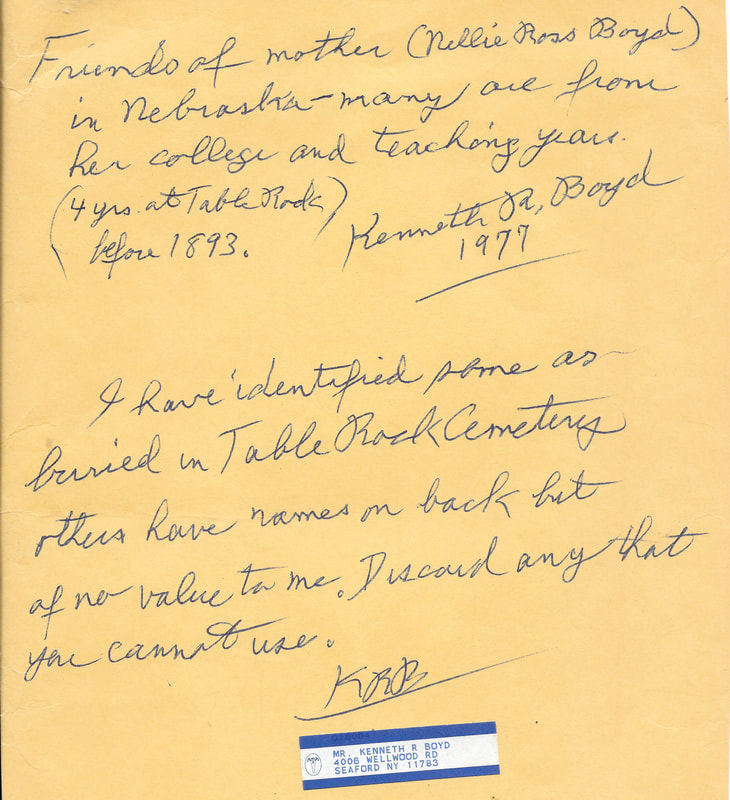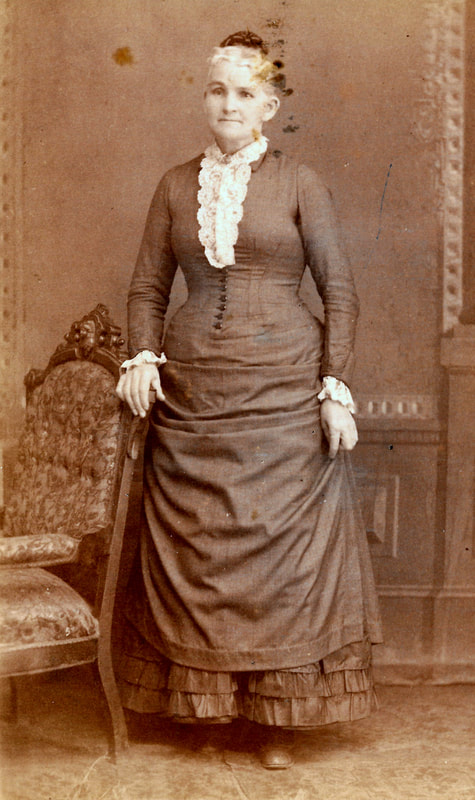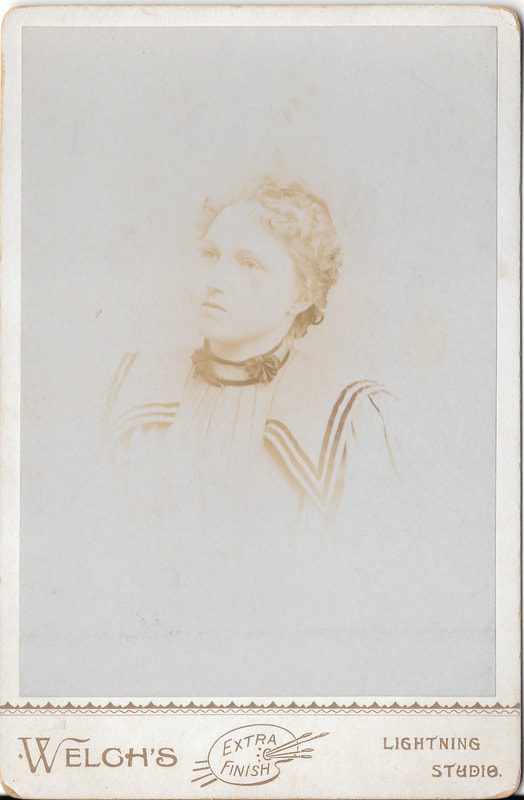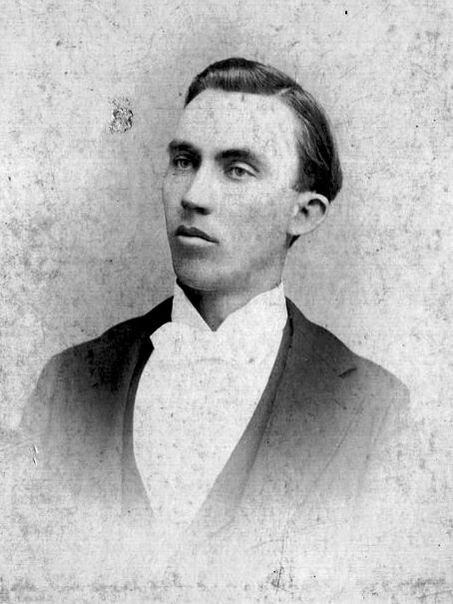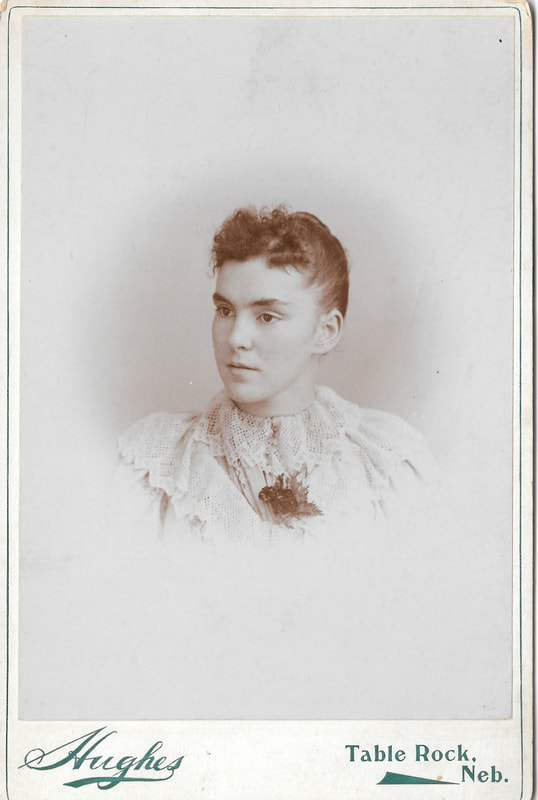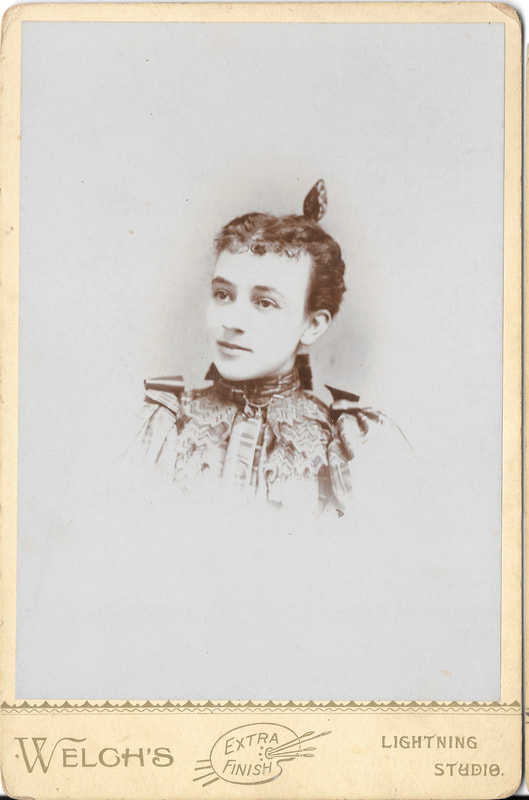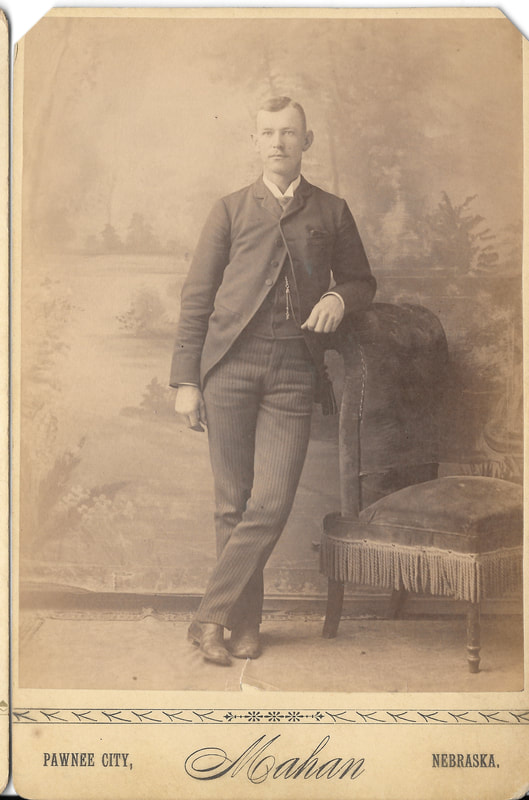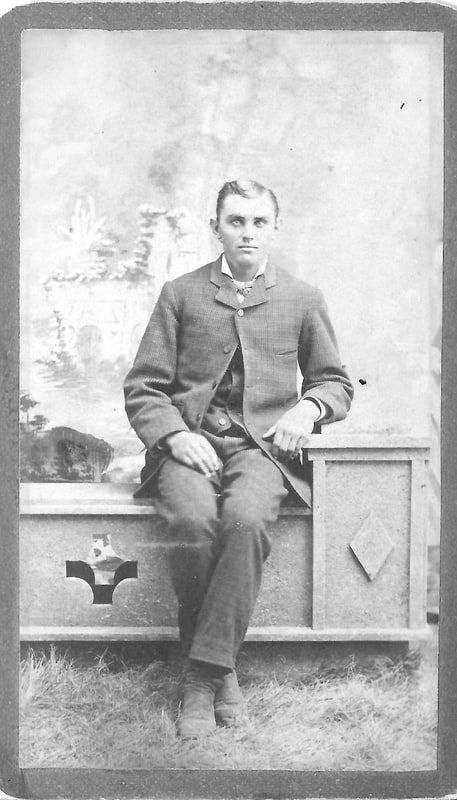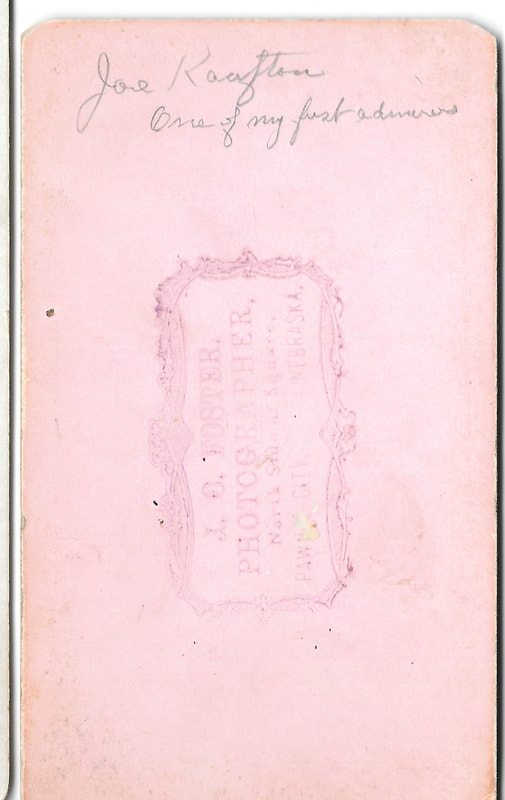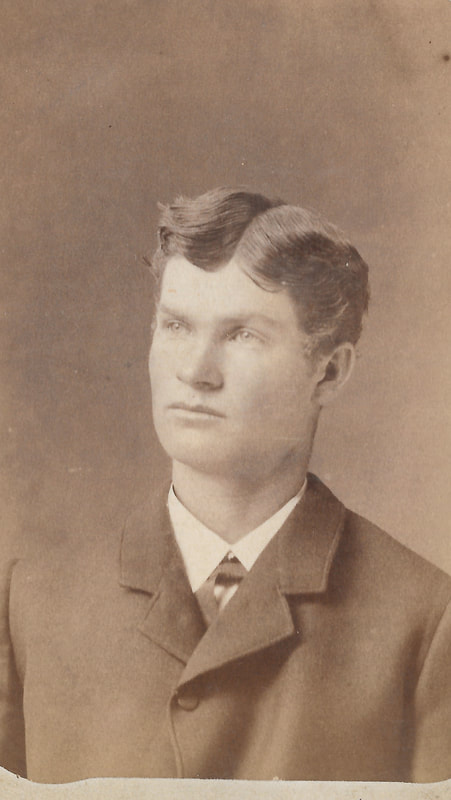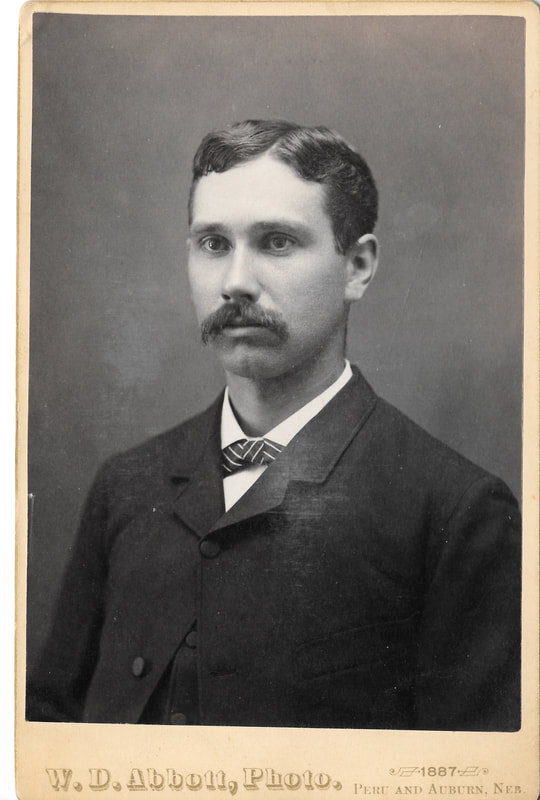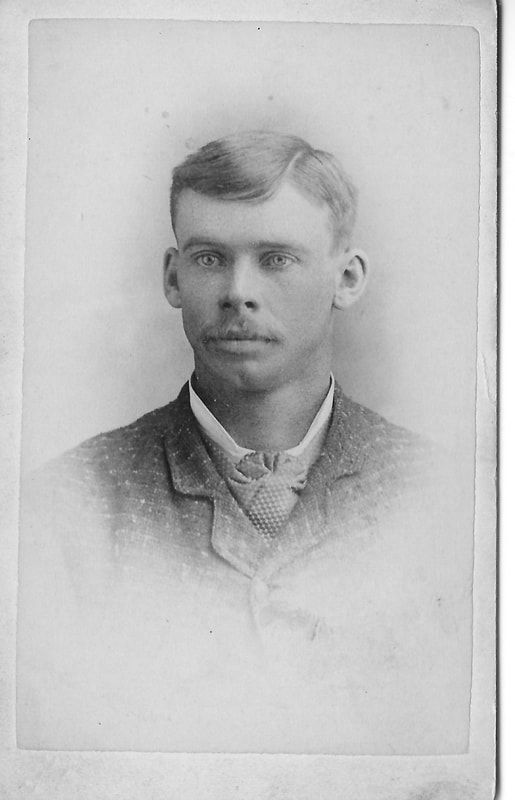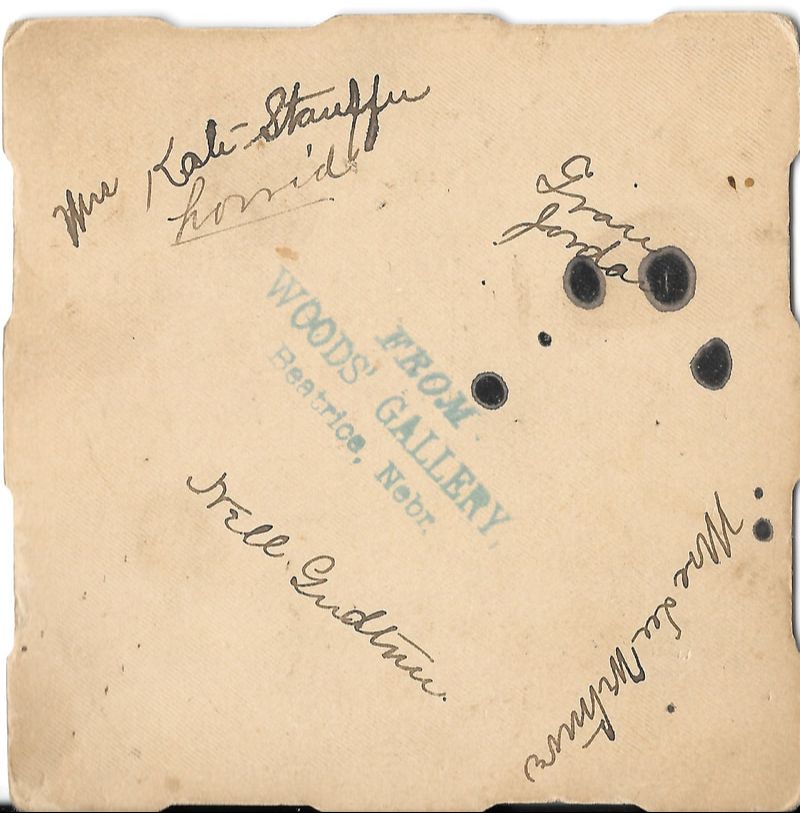photo collection of nellie griffing boyd
A small box of photographs in our collection contains some photographs of our early families. It is accompanied by a short letter from Kenneth Boyd (1897-1990). In it, he says that these are photographs of his mother's that are of her friends. (He apparently kept those of relatives). Those images are wonderful, even those that are not labeled. It is a very small collection, but an important one.
Kenneth Boyd's mother was Nellie Ross Griffing Boyd (1864-1951), daughter of Joseph and Lydia Ross Griffing (1827-1881, 1833-1898, married 1857). Sadly, we have no photographs of any of them.
Kenneth Boyd's mother was Nellie Ross Griffing Boyd (1864-1951), daughter of Joseph and Lydia Ross Griffing (1827-1881, 1833-1898, married 1857). Sadly, we have no photographs of any of them.
letter of kenneth boyd accompanying his donation of photos
Marilla chambers, a settler of 1857
On the back: "Mrs. Chambers, Aristocratic friend & neighbor, came west from Philadelphia."
|
Marilla (1828-1897) came to Table Rock with her husband William (1824-1870) in 1857. Those were trying times. In 1858, floods wiped out crops and homes and there was great illness and many of the settlers of 1857 left that year. The Chambers family was one of those who left. However, after the Civil War, they returned for good. That was 1867.
Three years after returning to Table Rock, Marilla's husband William died young, only 43. The next year, their six-year-old daughter Melissa died. Her other children Clarence "Mack" Chambers & Charles W. Chambers were well known in Table Rock. The latter, C. W., was quite a character -- he served as the depot agent in the early days of the railroad here, appearing in an 1887 photo of the depot, was the Nebraska state checkers champion for several years, and wrote a number of spirited opinion pieces for the local newspaper & the Nebraska State Journal. We have photographs of Marilla's children, but until we received Kenneth Boyd's donation in 1977, not Marilla. This is the only known image of her. |
benjamin & elizabeth ball, settlers of 1857
This photograph, labeled as "Mr. & Mrs. Ball" shows two of the first-wave settlers in their old age, Benjamin Ball (1823-1910) and his wife Elizabeth (1824-1908). They had one daughter, adopted, Emmaroy Doolittle Snoke, who married Civil War veteran Cosmus Snoke. Emma and Cosmus had triplets, who died as infants, and children Nellie, Mary, and George Snoke. Nellie married Lewis Marburger and had two stepsons and a son Charles. Lewis died in 1918, and Nellie ran the family shoe store in Humboldt, Nebraska. Nellie's grandson George Marburger still runs the family shoe store in Humboldt, Nebraska and is quite a ranconteur.
Benjamin & Elizabeth Ball came to Table Rock in 1857. They settled in Long Branch but after a couple of hears moved to a cabin north of Table Rock, where they lived for 25 years before then moving to town. They had an interesting Christmas in 1864 when a horse thief who had escaped lynching showed up at their door. He had been shot in the escape and knocked and asked for help. They were too afraid to open the door, and when they heard him stumbling toward the back, Ben left and ran to the neighbors for aid. At the neighbors he encountered a posse of citizens looking for the fugitive and they all headed back to the Ball cabin. The man was located; he had dug into a haystack to die. They took him into the cabin and laid him out rather than drag him back to Table Rock. As he lay there, he asked for a minister, and C. W. Giddings, a Methodist minister who is considered the founder of Table Rock, was sent for. Along with Giddings came Russel Samson and a man named Hurlbert. Giddings told the man that he would pray for him, but that the must also pray for himself, and Hurlburt added, "I'm not a praying man, but if I was you, I'd pray like hell!" Giddings prayed with him, but then let for town to try to persuade the folks there not to lynch the man but rather to wait for the law to come (which could be a year). It was said that he made the speech of his life but to no avail. Two others had been lynched the day before. Meanwhile back at the Ball cabin, presumably with the Balls still present, Samson and the thief conversed into the night, with the man telling his life story -- raised by a single mom, taught to do right but just couldn't quite do it, had a lovely sweet wife and had promised to quit, knew he deserved hanging and was ready for it. Toward morning, Samson heard the crowd coming. The man begged him to say, but Samson said he couldn't deal with it after having gotten to know him that night; Samson took up his hat and left. The horse thief was taken from the Ball's cabin. He couldn't walk on his own, so was carried to a horse. They led the horse to a tree behind the cabin and put a rope around his neck. "I'll do it myself," the man said when the time came and kicked the horse hard, and was hung.
Elizabeth Ball probably had to clean up the blood from the floor of her cabin and from the bed or wherever they had laid the man, and probably hung up clothes looking at that tree. Benjamin Ball probably found blood in his haystack and had other reminders of that night.
The Balls eventually moved to town. In 1880, they donated the lot where the present Methodist Church sits. There is a window in that church honoring them.
Ben's obituary says, "His early life was fraught with the dangers and privations incident of the pioneer life, and borne with the courage and determination which characterized the early settlers of Nebraska. He witnessed the transformation of the Nebraska Prairies into the beautiful and productive farms of today, and bore his part of the development, until the infirmities of age forced him to retire from active work, but Mr. Ball's influence was always for the right. He and his wife were earnest members of the M. E. church and the ground on which the church stands was given to the cause- a monument to their faithfulness." That would go as well for Elizabeth, the woman of the house, long before there were modern appliances for cooking and cleaning.
Until we received this photograph from Kenneth Boyd in 1977, we had no image of the Balls. This is the only one known.
Benjamin & Elizabeth Ball came to Table Rock in 1857. They settled in Long Branch but after a couple of hears moved to a cabin north of Table Rock, where they lived for 25 years before then moving to town. They had an interesting Christmas in 1864 when a horse thief who had escaped lynching showed up at their door. He had been shot in the escape and knocked and asked for help. They were too afraid to open the door, and when they heard him stumbling toward the back, Ben left and ran to the neighbors for aid. At the neighbors he encountered a posse of citizens looking for the fugitive and they all headed back to the Ball cabin. The man was located; he had dug into a haystack to die. They took him into the cabin and laid him out rather than drag him back to Table Rock. As he lay there, he asked for a minister, and C. W. Giddings, a Methodist minister who is considered the founder of Table Rock, was sent for. Along with Giddings came Russel Samson and a man named Hurlbert. Giddings told the man that he would pray for him, but that the must also pray for himself, and Hurlburt added, "I'm not a praying man, but if I was you, I'd pray like hell!" Giddings prayed with him, but then let for town to try to persuade the folks there not to lynch the man but rather to wait for the law to come (which could be a year). It was said that he made the speech of his life but to no avail. Two others had been lynched the day before. Meanwhile back at the Ball cabin, presumably with the Balls still present, Samson and the thief conversed into the night, with the man telling his life story -- raised by a single mom, taught to do right but just couldn't quite do it, had a lovely sweet wife and had promised to quit, knew he deserved hanging and was ready for it. Toward morning, Samson heard the crowd coming. The man begged him to say, but Samson said he couldn't deal with it after having gotten to know him that night; Samson took up his hat and left. The horse thief was taken from the Ball's cabin. He couldn't walk on his own, so was carried to a horse. They led the horse to a tree behind the cabin and put a rope around his neck. "I'll do it myself," the man said when the time came and kicked the horse hard, and was hung.
Elizabeth Ball probably had to clean up the blood from the floor of her cabin and from the bed or wherever they had laid the man, and probably hung up clothes looking at that tree. Benjamin Ball probably found blood in his haystack and had other reminders of that night.
The Balls eventually moved to town. In 1880, they donated the lot where the present Methodist Church sits. There is a window in that church honoring them.
Ben's obituary says, "His early life was fraught with the dangers and privations incident of the pioneer life, and borne with the courage and determination which characterized the early settlers of Nebraska. He witnessed the transformation of the Nebraska Prairies into the beautiful and productive farms of today, and bore his part of the development, until the infirmities of age forced him to retire from active work, but Mr. Ball's influence was always for the right. He and his wife were earnest members of the M. E. church and the ground on which the church stands was given to the cause- a monument to their faithfulness." That would go as well for Elizabeth, the woman of the house, long before there were modern appliances for cooking and cleaning.
Until we received this photograph from Kenneth Boyd in 1977, we had no image of the Balls. This is the only one known.
laura mumford - granddaughter of settlers of 1857, born in 1875
Until Kenneth Boyd donated this photo, we had no images of anyone in the Mumford family. Laura was a granddaughter of the original settlers, but this is the only photograph of any of the family.
Martin Mumford and family came to Table Rock in 1857. Their children included children Luther (1831-1882), Ruby (1836-1895), Frances (1839-1911), Thomas (1840-1914), and Henry (1846-1877). Their daughter Frances married Asa Heywood, another settler of 1857. All three boys fought in the Civil War.
Henry Mumford, the youngest of Martin & Maria's children, was Laura's father . Her mother was Melissa Huntley, the youngest of a family of nine children who had come to the area in 1856. Henry and Laura married in 1868 and moved to a farm. They had a little girl in 1870, Alice, then in 1871 a little boy, Martin. In 1872, little Alice died and was buried in the Table Rock Cemetery. That same year, Henry became very ill. The family moved into town. In 1875, Laura was born there. Henry died in 1877, leaving Melissa with two-year-old Laura and six-year-old Martin. Henry is buried next to Alice.
In 1895, Laura Mumford married Carl C. Covert, a dentist. They had one child, Marjorie. In 1912, they left Table Rock. Laura's husband died in 1946 at the age of 74, but Laura lived an even longer life. She died in 1965, on the verge of turning 90. Both she and her husband are buried next to Henry. Their graves are unmarked.
Martin Mumford and family came to Table Rock in 1857. Their children included children Luther (1831-1882), Ruby (1836-1895), Frances (1839-1911), Thomas (1840-1914), and Henry (1846-1877). Their daughter Frances married Asa Heywood, another settler of 1857. All three boys fought in the Civil War.
Henry Mumford, the youngest of Martin & Maria's children, was Laura's father . Her mother was Melissa Huntley, the youngest of a family of nine children who had come to the area in 1856. Henry and Laura married in 1868 and moved to a farm. They had a little girl in 1870, Alice, then in 1871 a little boy, Martin. In 1872, little Alice died and was buried in the Table Rock Cemetery. That same year, Henry became very ill. The family moved into town. In 1875, Laura was born there. Henry died in 1877, leaving Melissa with two-year-old Laura and six-year-old Martin. Henry is buried next to Alice.
In 1895, Laura Mumford married Carl C. Covert, a dentist. They had one child, Marjorie. In 1912, they left Table Rock. Laura's husband died in 1946 at the age of 74, but Laura lived an even longer life. She died in 1965, on the verge of turning 90. Both she and her husband are buried next to Henry. Their graves are unmarked.
henry shaw, born in 1872, son of early settlers
Henry Shaw was one of the two children of John W. Shaw (1837-1920) and wife Maria (1844-1921). John & Maria married in 1867 and came here that same year as newly weds. Their first child, Alice Shaw Nickelson, was born in 1868 and then Joseph Henry ("Henry") in 1872. Henry grew up here, and had a business here, but eventually moved to Oklahoma, where he was in the grain business. Henry would have had a country school education; the first high school class did not graduate from Table Rock until he was an adult. Henry married Maud Bain, whose parents also were early settlers, and whose photograph was also in Nellie Griffing Boyd's collection.
Henry's father John W. Shaw had been injured at the battle of Shiloh, shot in the knee, which left him fairly disabled. John came to Table Rock with his wife's relatives.
Henry's father John W. Shaw had been injured at the battle of Shiloh, shot in the knee, which left him fairly disabled. John came to Table Rock with his wife's relatives.
maud bain, came with her family in 1879 at the age of 5, married henry shaw
Maud Bain was one of the seven children of Isam & Catherine Smith Bain (1847-1927, 1850-1932). Isam & Catherine first homesteaded in Kansas, but came to Table Rock in 1879. Maud, the second oldest, was then five years old. She grew up here. She had a country school education, apparently, as she is not on a list of Table Rock alumni. Of course, that was not unusual for the day.
Maud's parents are buried in the Table Rock. She and Henry are buried in Oklahoma.
This is the only known image of Maud Bain Shaw.
Maud's parents are buried in the Table Rock. She and Henry are buried in Oklahoma.
This is the only known image of Maud Bain Shaw.
"mamma jobe"
This photograph of a young woman showing off her tiny waist is labeled as "Mamma Jobe." In April 2020, we asked Karen Keehr, curator of the photograph collection of History Nebraska (formerly the Nebraska State Historical Society) her opinion about when this picture may have been taken. She consulted with a mentor, Kay Cynova at the Stuhr Museum, who Karen says taught her about dating photographs based on fashion, and they both agree that it was taken probably 1897-1900.
Who is "Mamma Jobe"? If she is "Mamma" Job, then that is presumably a married name, and we don't know her maiden name. She would have been married to a Jobe son.
There was a Jobe family in Table Rock, showing up on the 1885 state census and on the 1900 federal census. Samuel & Elta Jobe were married in 1874. In 1900, they were ages 53 and 45. There was a daughter, Nellie, born in 1875, and in 1900 the children of the Jobe family still living at home in 1900 were Fred (age 22), Olie (age 17), Vivian (age 15), Irvie (age 12), Edgar (age 9), Lilas (age 6), and Dorr (age 1). After Fred, the next son in order was Edgar, born about 1891, almost certainly too young to have married a young lady of this age.
We think this young lady became the wife of Fred Job -- Iva Robertson, daughter of Prince and Belle Allen Jobe of Humboldt. On November 11, 1901, Justice of the Peace Milton H. Marble of Table Rock married Fred and Iva, who was then 18, see the Pawnee County marriage log. This photograph could well have been her wedding photo in 1901, which is not so far off from the estimate of 1897-1900. Iva and her younger siblings were born in Humboldt; Iva was the oldest, born in 1883, and Ivan the youngest, born 1898. Fred & Iva had three children, Juanita, or Wuaneta (1903-1987), Ruth Shepard Bunt (1906-1997), and Alice (1915-2009), all born in Kansas. Was this young lady their mamma, then? In the end, we don't know, but this is the best guess of the history detectives of Table Rock.
If you actually know who this is, please let us know at [email protected]!
Who is "Mamma Jobe"? If she is "Mamma" Job, then that is presumably a married name, and we don't know her maiden name. She would have been married to a Jobe son.
There was a Jobe family in Table Rock, showing up on the 1885 state census and on the 1900 federal census. Samuel & Elta Jobe were married in 1874. In 1900, they were ages 53 and 45. There was a daughter, Nellie, born in 1875, and in 1900 the children of the Jobe family still living at home in 1900 were Fred (age 22), Olie (age 17), Vivian (age 15), Irvie (age 12), Edgar (age 9), Lilas (age 6), and Dorr (age 1). After Fred, the next son in order was Edgar, born about 1891, almost certainly too young to have married a young lady of this age.
We think this young lady became the wife of Fred Job -- Iva Robertson, daughter of Prince and Belle Allen Jobe of Humboldt. On November 11, 1901, Justice of the Peace Milton H. Marble of Table Rock married Fred and Iva, who was then 18, see the Pawnee County marriage log. This photograph could well have been her wedding photo in 1901, which is not so far off from the estimate of 1897-1900. Iva and her younger siblings were born in Humboldt; Iva was the oldest, born in 1883, and Ivan the youngest, born 1898. Fred & Iva had three children, Juanita, or Wuaneta (1903-1987), Ruth Shepard Bunt (1906-1997), and Alice (1915-2009), all born in Kansas. Was this young lady their mamma, then? In the end, we don't know, but this is the best guess of the history detectives of Table Rock.
If you actually know who this is, please let us know at [email protected]!
the allinson family
helen allinson
Helen Allinson Endelman (1876-1966) was one of the children of Adam and Leonora Allinson (1833-1918, 1836-1907). Adam and Leonora married in 1858 and they had five childrn. One child, Susan Allinson Fulton (1860-1940), was born before before Adam enlisted to fight in the Civil War. Their other children were born after his return: Franklin (1864-1953), Walter (1864-1955), Albert (1867-1937) , and Helen (1876-1966). The family came to Table Rock in 1888.
There are two photographs of Helen in Nellie Griffing Boyd's collection. This first photo was taken at Welch's Lightning Studio -- a photographer in nearby Elk Creek. Neither photograph is dated.
There are two photographs of Helen in Nellie Griffing Boyd's collection. This first photo was taken at Welch's Lightning Studio -- a photographer in nearby Elk Creek. Neither photograph is dated.
frank allinson
Franklin Allinson, older brother of Helen, above. The photo was taken at a studio in Pawnee City.
joe kaafton (sic?)
"Joe Kaafton, One of my first admirers," wrote Nellie Griffing Boyd on the back of this photograph. Who was he? We are pretty sure that he is a Joe Kafton, also spelled Kofton and Koftan), born in Bohemia in 1861. He was just three years older than Nellie. The 1880 federal census lists the "Koftan" family and shows Oliver Griffing and wife as next door neighbors, and George Griffing and family as only a few houses away. On the same census, Nellie (then 15) lived with her family (Joseph and Lydia Griffing) and were listed about 10 houses ahead of the Kafton's. Nellie and Joe were about the same age, and that Joe Kafton was her first admirer is likely; the name was vaguely spelled, and they were neighbors as were relatives of Nellie's.
One family tree on Ancestry.com ("kimkuney") lists Joe as born in 1861, and reflects that in 1886 he married Frances "Fannie" Hlinovsky (he was about 25) and they had eight children. He died in 1945. (Nellie says that he was her "earliest" admirer, so they may have been children together, not necessarily teenagers or of courting age. Nellie married Alvy Boyd in 1893 when she was about 29.
One family tree on Ancestry.com ("kimkuney") lists Joe as born in 1861, and reflects that in 1886 he married Frances "Fannie" Hlinovsky (he was about 25) and they had eight children. He died in 1945. (Nellie says that he was her "earliest" admirer, so they may have been children together, not necessarily teenagers or of courting age. Nellie married Alvy Boyd in 1893 when she was about 29.
people who are identified, but not from table rock
Kenneth Boyd's letter mentioned that his mother was at school in Peru and that some of the photographs were of friends there. We have been unable to find anything out about these people and presume they are not from Table Rock but rather were friends at college.
lee stearns
george tichman & ellis good
bert McMullen
harvey kingsley
|
The only potential Harvey Kinglsey we have found was born in New York in 1861, and lived in Omaha with his mother and sister in 1880, age 19, occupation laborer. He married Miss Docia Emerson in Johnson County, Nebraska (adjacent to Pawnee County) and she died in 1895. There is only one family tree on Ancestry.com, with many misspellings and no other information than this. If the Omaha lad was Nellie's friend, we have no idea how they met or where. Was he a friend at Peru State Normal School? Perhaps he taught school before he became a laborer? The young man in the photograph is very young and certainly doesn't have the appearance of a laborer, but the family may have come on hard times, perhaps when the father died. The history detectives have found nothing more.
|
Four friends in a photo taken in beatrice
This photograph taken at a Beatrice studio gives names. One is "Mrs. Kate Stauffer," which Nellie notes is a "horrid" photo of her. The way the photograph is labeled makes it difficult to tell who is who. It seems that Kate is the one on the top. There is another photo in the collection identified as the Stauffer family of Burchard. At the right is Grace....Jonda? At the bottom is "Mrs. Lee Whitmore" (sic?), and at the left is Nelle G_____. This is if the names are associated correctly. None of these are known Table Rock names.
